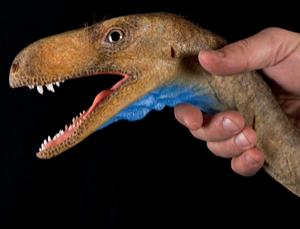La Formación Ischigualasto es muy conocida entre los investigadores de vertebrados del Mesozoico por su abundancia en restos fósiles. Anteriormente se habían encontrado dinosaurios famosos como Eoraptor, que desde su descubrimiento se había clasificado como un terópodo primitivo. Sin embargo la investigación de Martínez y colaboradores demuestra también que Eoraptor es en realidad un sauropodomorfo, es decir un ancestro lejano de los grandes saurópodos del Jurásico y el Cretácico. Aparentemente puede parecer un cambio sistemático muy importante, pero hay que tener en cuenta que en le Triásico superior el plan corporal de los ornitisquios, sauropomorfos y los terópodos era muy similar. Nos encontramos en el momento en que se están separando morfológicamente por lo que las diferencias son sutiles, y cada nuevo descubrimiento como el Eodromaeus nos ayuda a dibujar las finas separaciones.
La referencia completa en:
Martinez, R. N., Sereno, P. C., Alcober, O. A., Colombi, C. E., Renne, P. R., Montañez, I. P., and B. S. Currie. 2011. A Basal Dinosaur from the Dawn of the Dinosaur Era in Southwestern Pangaea. Science 331:206-210 DOI: 10.1126/science.1198467.
Abstract - Upper Triassic rocks in northwestern Argentina preserve the most complete record of dinosaurs before their rise to dominance in the Early Jurassic. Here, we describe a previously unidentified basal theropod, reassess its contemporary Eoraptor as a basal sauropodomorph, divide the faunal record of the Ischigualasto Formation with biozones, and bracket the formation with 40Ar/39Ar ages. Some 230 million years ago in the Late Triassic (mid Carnian), the earliest dinosaurs were the dominant terrestrial carnivores and small herbivores in southwestern Pangaea. The extinction of nondinosaurian herbivores is sequential and is not linked to an increase in dinosaurian diversity, which weakens the predominant scenario for dinosaurian ascendancy as opportunistic replacement.
Enlaces a New Scientist, Live Science,
La referencia completa en:
Martinez, R. N., Sereno, P. C., Alcober, O. A., Colombi, C. E., Renne, P. R., Montañez, I. P., and B. S. Currie. 2011. A Basal Dinosaur from the Dawn of the Dinosaur Era in Southwestern Pangaea. Science 331:206-210 DOI: 10.1126/science.1198467.
Abstract - Upper Triassic rocks in northwestern Argentina preserve the most complete record of dinosaurs before their rise to dominance in the Early Jurassic. Here, we describe a previously unidentified basal theropod, reassess its contemporary Eoraptor as a basal sauropodomorph, divide the faunal record of the Ischigualasto Formation with biozones, and bracket the formation with 40Ar/39Ar ages. Some 230 million years ago in the Late Triassic (mid Carnian), the earliest dinosaurs were the dominant terrestrial carnivores and small herbivores in southwestern Pangaea. The extinction of nondinosaurian herbivores is sequential and is not linked to an increase in dinosaurian diversity, which weakens the predominant scenario for dinosaurian ascendancy as opportunistic replacement.
Enlaces a New Scientist, Live Science,
LUGAR Argentina



















